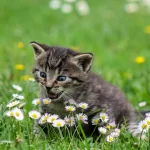You may have jumped in shock when you suddenly heard the heartbreaking meow of a copulating cat. Because, honestly, their way of manifesting their instincts during the reproductive process is not very acceptable to humans. But do you know why cats scream when they mate? In the following article, we will give you the reasons, which are not far from the nature of the animal.
It is not the male cat, it is the female cat that makes the loud noises. It is not a subhuman condition in which cats are connecting with evil spirit entities or from another parallel universe, not at all. What happens is that once the female cat accepts the male and they finish the act of mating, the female cat emits a signal when stimulated by the cat to activate ovulation. It doesn’t hurt them; when the cat meows in such a way, it is because copulation is over.
The first thing you should know is that the reproductive organ of the male cat is quite particular, compared to dogs, but nothing strange among some animal species.
What happens with this is that the cat’s penis has a series of physiological characteristics that add hard and rigid parts called spicules; it could be said that they are a kind of very small spikes or similar things, in proportion to the size of the limb, which is reduced.
Those spikes or small thorns that surround the cat’s penis, really are more like hardened keratin hairs which is why they acquire the shape of tiny thorns.
The answer to this is no, but it depends on the time in which the cat has been intervened to neuter, because if this is carried out before the pet reaches the stage of sexual maturity, which goes from 5 to 8 months, the safest thing is that he has not developed this part of his body, so he will reach adulthood without keratin hairs forming.
This is a condition of cats of which there is less certainty, however, the reasons that specialists offer as a result of the study of the physiognomic conditions of such characteristics, their formation, and location, show two uses in the cat’s penis:
The first of these, and perhaps the most logical, is that, during the reproductive process with the cat, these so-called spikes or quills tear the walls of the female’s vagina, moderately to stimulate and ensure ovulation. It must be emphasized that felines are a highly reproductive species by nature, due to their vulnerability.
The second reason is linked to the performance of the male. Well, it is considered that these lifts in the penis of cats help the male cat to accelerate its physical stimulation and can guarantee successful fertilization in the shortest time invested. As already mentioned, the main purpose of these animals is to ensure reproduction and preserve the species.

As you read it, the reproductive organ of the male cat has a bone called the “penile bone” and what is it for?! Well, as it happens as a cat, has a bone called the penile bone or staff, this curious characteristic is precisely a trait that both cats and dogs share.
The penile bone is a fairly small bone structure, which is located on the inside of the penis of cats. The function of this small bone is to aid the penetration of the female cat and allow the animal’s penis to remain erect for a longer time.
It begins when the female cat enters the stage of sexual adulthood, from that moment on, the female will begin her mating ritual; she begins to make a series of movements, frictions, and pirouettes quite noticeable, to claim the attention of those around her, but mainly of the males.
It involves a whole series of phases that the cat goes through to ensure that the male cat heeds her requests, understands the message, and the reproductive act is consumed.
Once the female has gone through her four phases of zeal or “menstruation” if you want to call it that, although the cats do not present any hemorrhage and her cycle of heat is not exactly monthly. After this, the cat will prepare to be penetrated, positioning its body diagonally, tilting its front legs and head as low as possible, raising its tail, and giving a movement to its rear legs that resemble to a suggestive walk.
When this happens, the cat proceeds to mount the female, biting her neck to keep her in the mating position thus, once the cat has accepted it, ensure that the act will continue. Well, in general, the female tends to take an aggressive attitude a few minutes after copulation is completed.
The entire mating process happens quite quickly, by this, we mean ejaculation and the previous minutes. Once it is finished, it is when the cat should move away from the female cat almost immediately, because she will respond in an attacking way to drive him away with her nails. For this reason, “alpha males” are often seen with lesions and scratches on their faces but sometimes, they are the product of fights with other males to take the female.
The feline, despite being moved away by the female cat, tends to maintain an alert position near its female, because, as with most animals, when a female is in heat, nearby males will want to mount her and that is precisely what the strongest cat will want to avoid. Although many times, it happens that a second cat achieves his mission.
Another important thing, which happens throughout this process, is the fight for the female and this is another reason why cats scream when they mate. Sometimes, you can hear loud fights between cats, in which it is difficult to differentiate if it is the female or it is two males fighting to mount the cat. Many of these fights result in serious injuries, infections, and even complications that can lead to health problems for pets.
Unlike females, which at practically 6 months may be entering their first heat phase, cats experience sexual maturity a few months later, around 8 months. Of course, this varies depending on the environment in which the animal is raised and the climatic conditions of the space in which the animal developed.
During that period of sexual maturity, or heat that the cat experiences, it usually meows very loudly and leaves sprays of its urine in different parts, to show that this smell characterizes it, that it is an adult male and the territory belongs to it; The smell is often difficult for the owners to bear, and it is usually confused with some disease in the animal, but if your pet has accompanied you since he was a puppy, it is completely natural for this to occur.
It also happens that cats in heat take a more restless attitude, even becoming a little aggressive; this is linked to the animal trying to escape from home and getting lost for a few days. It is a stage of discovery for these animals, where they want to explore the changes in their system and want to demonstrate their adulthood.
In the case of cats, the female is characterized more than all because they are “seasonally polyestrous”, which means that during the year she has a period in which her reproductive system is activated, which will be conditioned by how much The days last, which translates into, while the days are longer, there will be more hours with light, therefore, the appearance of heat will be longer.
For sure, puberty in cats, only in general terms, but not as a normal or biological pattern, occurs between 4 and 12 months of age, being more frequent between 6 and 9 months, but as we have already said, several factors determine the arrival of this stage in felines.
Nowadays, it is not strange that kittens are sterilized before they are sexually fit, at ages 6 to 8 weeks; this is done mostly when living in an area where there is an overpopulation of felines. A very common problem because their biological nature allows them to reproduce very quickly.
If you want to prevent your cat from getting pregnant and you want your male cat not to fight with other cats, the best and wisest decision is to sterilize them.




